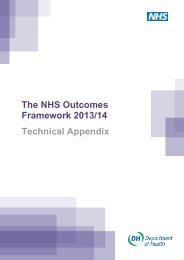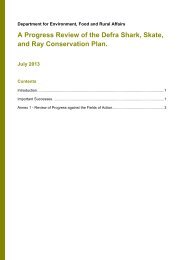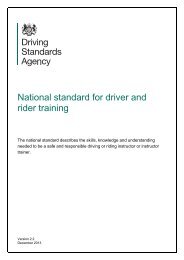Decontamination in primary care dental practices - Gov.uk
Decontamination in primary care dental practices - Gov.uk
Decontamination in primary care dental practices - Gov.uk
You also want an ePaper? Increase the reach of your titles
YUMPU automatically turns print PDFs into web optimized ePapers that Google loves.
6 General hygiene pr<strong>in</strong>ciples6.71 Portable aspirators with reservoir bottles are notrecommended. They are not fitted with filters andpose a considerable hazard when dispos<strong>in</strong>g of thecontents.6.72 Intra-oral radiology film and devices used <strong>in</strong> digitalradiology imag<strong>in</strong>g are potential sources of cross<strong>in</strong>fection.Accord<strong>in</strong>gly, where reusable devices areused, they should be decontam<strong>in</strong>ated <strong>in</strong> accordancewith the manufacturer’s <strong>in</strong>structions. For <strong>in</strong>tra-oralholders, this will require the use of steamsterilization follow<strong>in</strong>g wash<strong>in</strong>g and dis<strong>in</strong>fection.6.73 Soft toys are often difficult to clean and shouldaccord<strong>in</strong>gly not be provided with<strong>in</strong> <strong>practices</strong>.6.74 For blood spillages, <strong>care</strong> should be taken toobserve a protocol that ensures protection aga<strong>in</strong>st<strong>in</strong>fection. The use of hypochlorite at 1000 ppmavailable chlor<strong>in</strong>e is recommended. Hypochloriteshould be made up either freshly us<strong>in</strong>ghypochlorite-generat<strong>in</strong>g tablets or at least weekly <strong>in</strong>clean conta<strong>in</strong>ers. Contact times should bereasonably prolonged (not less than five m<strong>in</strong>utes).A higher available chlor<strong>in</strong>e concentration of 10,000ppm is useful, particularly for bloodcontam<strong>in</strong>ation. The process should be <strong>in</strong>itiatedquickly and <strong>care</strong> should be taken to avoid corrosivedamage to metal fitt<strong>in</strong>gs etc. The use of alcoholwith<strong>in</strong> the same decontam<strong>in</strong>ation process is notadvised.Dental unit water l<strong>in</strong>es (DUWLs)NoteIn view of the expertise required <strong>in</strong> this specialisedfield, <strong>practices</strong> (through the Registered Manager)should engage with an external specialist to assist <strong>in</strong>meet<strong>in</strong>g the recommendations given <strong>in</strong> Section 3 ofthis guidance. This may be a locally-based eng<strong>in</strong>eer<strong>in</strong>gconsultant with specialist knowledge of Legionella andother water-borne organisms.General6.75 Best practice guidel<strong>in</strong>es on the control of Legionellaare provided <strong>in</strong> the Health & Safety Commission’s‘Legionnaires’ disease – the control of Legionellabacteria <strong>in</strong> water systems. Approved Code ofPractice & guidance’ (also known as L8) andHealth Technical Memorandum 04-01 – ‘Thecontrol of Legionella, hygiene, “safe” hot water,cold water and dr<strong>in</strong>k<strong>in</strong>g water systems’.NoteThe Health & Safety Commission’s Approved Code ofPractice L8 gives practical advice on how to complywith UK health and safety law with respect to thecontrol of Legionella bacteria. This Code is important<strong>in</strong> that it has a special legal status. If a health<strong>care</strong>organisation is prosecuted for a breach of health andsafety law, and it is held that it did not follow therelevant provisions of the Code, that organisationwould need to demonstrate that it had complied withthe law <strong>in</strong> some other way, or a court would f<strong>in</strong>d it atfault.6.76 The use of water <strong>in</strong> dentistry must comply with aseries of regulations which are designed to ensurethe safety of patients, staff and the public. Theapplication of these regulations and codes iscovered <strong>in</strong> detail <strong>in</strong> Chapter 19 of this guidance.6.77 The Registered Manager (see paragraph 9.3) shouldensure that arrangements are made such that thepractice can cont<strong>in</strong>uously achieve compliance withthe requirements of these regulations. Registrationwith the Legionella Control Association or otherrecognised body is recommended.Microbiological monitor<strong>in</strong>g6.78 Apart from situations where there are <strong>in</strong>dicationsfrom taste or odour, microbiological monitor<strong>in</strong>gus<strong>in</strong>g dip slides for total viable counts (TVCs) isnot considered essential. However, some companiesand other <strong>in</strong>stitutions offer comprehensive waterpurificationservices that <strong>in</strong>clude periodicmicrobiological sample monitor<strong>in</strong>g. Such services,provided they are quality-controlled, maycontribute usefully to risk reduction <strong>in</strong> this area.6.79 Where monitor<strong>in</strong>g is undertaken, the TVC shouldbe expected to lie <strong>in</strong> the range 100 to 200 colonyform<strong>in</strong>g units per millilitre (cfu/ml). In general,<strong>in</strong>cubation should be at 22oC. These measurementscan be carried out by commercial microbiologicalservices or by Public Health England. (Somecommercial water-purification services offermicrobiological control such that TVC values maybe ma<strong>in</strong>ta<strong>in</strong>ed below 10 cfu/ml.)NoteThis is a complex procedure and the use of <strong>in</strong>-housetest kits is not recommended.39
















